Fresnel Lens Solar-Pumped Laser with Four Rods and Beam Merging Technique for Uniform and Stable Emission under Tracking Error Influence
Abstract
1. Introduction
2. Fresnel Lens Nd:YAG Four-Rod Solar Laser System
2.1. Fresnel Lens Solar Concentration System
2.2. Four-Rod Solar Laser Side-Pumping Scheme
3. Numerical Analysis of the Nd:YAG Four-Rod Solar Laser
3.1. Ray Tracing Performance of the Nd:YAG Four-Rod Solar Laser
3.2. LASCADTM Laser Output from the Four-Rod Solar Laser
4. Fresnel Lens Four-Rod Thermal Performance Analysis
5. Nd:YAG Four-Rod Scheme Solar Laser with Fresnel Lenses under Tracking Error Influence
6. Fresnel Lens Four-Rod Scheme with Beam Merging Technique
7. Discussions
8. Conclusions
Author Contributions
Funding
Data Availability Statement
Acknowledgments
Conflicts of Interest
References
- Overton, G. NOVEL LASERS: “Solar-Pumped Nd:YAG Lasers Getting Brighter”; Laser Focus World: Nashua, NH, USA, 2013. [Google Scholar]
- Lando, M.; Shimony, Y.; Benmair, R.M.J.; Abramovich, D.; Krupkin, V.; Yogev, A. Visible solar-pumped lasers. Opt. Mater. 1999, 13, 111–115. [Google Scholar] [CrossRef]
- Takashi, Y.; Tomomasa, O.; Hung, D.T.; Hiroki, K.; Junichi, N.; Kouta, O. Demonstration of Solar-Pumped Laser-Induced Magnesium Production from Magnesium Oxide. Magnes. Technol. 2012, 2012, 55–58. [Google Scholar] [CrossRef]
- Graham-Rowe, D. Solar-powered lasers. Nat. Photonics 2010, 4, 64–65. [Google Scholar] [CrossRef]
- Motohiro, T.; Takeda, Y.; Ito, H.; Hasegawa, K.; Ikesue, A.; Ichikawa, T.; Higuchi, K.; Ichiki, A.; Mizuno, S.; Ito, T.; et al. Concept of the solar-pumped laser-photovoltaics combined system and its application to laser beam power feeding to electric vehicles. Jpn. J. Appl. Phys. 2017, 56, 08MA07. [Google Scholar] [CrossRef]
- Yabe, T.; Uchida, S.; Ikuta, K.; Yoshida, K.; Baasandash, C.; Mohamed, M.S.; Sakurai, Y.; Ogata, Y.; Tuji, M.; Mori, Y.; et al. Demonstrated fossil-fuel-free energy cycle using magnesium and laser. Appl. Phys. Lett. 2006, 89, 261107. [Google Scholar] [CrossRef]
- Young, C.G. A Sun-Pumped cw One-Watt Laser. Appl. Opt. 1966, 5, 993–997. [Google Scholar] [CrossRef]
- Weksler, M.; Shwartz, J. Solar Pumped Solid State Lasers; SPIE: Bellingham, WA, USA, 1987; Volume 0736. [Google Scholar]
- Arashi, H.; Oka, Y.; Sasahara, N.; Kaimai, A.; Ishigame, M. A Solar-Pumped cw 18 W Nd:YAG Laser. Jpn. J. Appl. Phys. 1984, 23, 1051–1053. [Google Scholar] [CrossRef]
- Benmair, R.M.J.; Kagan, J.; Kalisky, Y.; Noter, Y.; Oron, M.; Shimony, Y.; Yogev, A. Solar-pumped Er,Tm,Ho:YAG laser. Opt. Lett. 1990, 15, 36–38. [Google Scholar] [CrossRef]
- Lando, M.; Kagan, J.; Linyekin, B.; Dobrusin, V. A solar-pumped Nd:YAG laser in the high collection efficiency regime. Opt. Commun. 2003, 222, 371–381. [Google Scholar] [CrossRef]
- Liang, D.; Vistas, C.R.; Tibúrcio, B.D.; Almeida, J. Solar-pumped Cr:Nd:YAG ceramic laser with 6.7% slope efficiency. Sol. Energy Mater. Sol. Cells 2018, 185, 75–79. [Google Scholar] [CrossRef]
- Liang, D.; Vistas, C.R.; Garcia, D.; Tibúrcio, B.D.; Catela, M.; Costa, H.; Guillot, E.; Almeida, J. Most efficient simultaneous solar laser emissions from three Ce:Nd:YAG rods within a single pump cavity. Sol. Energy Mater. Sol. Cells 2022, 246, 111921. [Google Scholar] [CrossRef]
- Cai, Z.; Zhao, C.; Zhao, Z.; Zhang, J.; Zhang, Z.; Zhang, H. Efficient 38.8 W/m2 solar pumped laser with a Ce:Nd:YAG crystal and a Fresnel lens. Opt. Express 2023, 31, 1340–1353. [Google Scholar] [CrossRef]
- Yabe, T.; Ohkubo, T.; Uchida, S.; Yoshida, K.; Nakatsuka, M.; Funatsu, T.; Mabuti, A.; Oyama, A.; Nakagawa, K.; Oishi, T.; et al. High-efficiency and economical solar-energy-pumped laser with Fresnel lens and chromium codoped laser medium. Appl. Phys. Lett. 2007, 90, 261120. [Google Scholar] [CrossRef]
- Liang, D.; Almeida, J. Highly efficient solar-pumped Nd:YAG laser. Opt. Express 2011, 19, 26399–26405. [Google Scholar] [CrossRef]
- Dinh, T.H.; Ohkubo, T.; Yabe, T.; Kuboyama, H. 120 watt continuous wave solar-pumped laser with a liquid light-guide lens and an Nd:YAG rod. Opt. Lett. 2012, 37, 2670–2672. [Google Scholar] [CrossRef]
- Xu, P.; Yang, S.; Zhao, C.; Guan, Z.; Wang, H.; Zhang, Y.; Zhang, H.; He, T. High-efficiency solar-pumped laser with a grooved Nd:YAG rod. Appl. Opt. 2014, 53, 3941–3944. [Google Scholar] [CrossRef]
- Liang, D.; Almeida, J. Solar-Pumped TEM00-mode Nd:YAG laser. Opt. Express 2013, 21, 25107–25112. [Google Scholar] [CrossRef]
- Jing, L.; Liu, H.; Wang, Y.; Xu, W.; Zhang, H.; Lu, Z. Design and Optimization of Fresnel Lens for High Concentration Photovoltaic System. Int. J. Photoenergy 2014, 2014, 7. [Google Scholar] [CrossRef]
- Guan, Z.; Zhao, C.; Li, J.; He, D.; Zhang, H. 32.1 W/m2 continuous wave solar-pumped laser with a bonding Nd:YAG/YAG rod and a Fresnel lens. Opt. Laser Technol. 2018, 107, 158–161. [Google Scholar] [CrossRef]
- Liang, D.; Almeida, J.; Vistas, C.R.; Guillot, E. Solar-pumped Nd:YAG laser with 31.5 W/m2 multimode and 7.9 W/m2 TEM00-mode collection efficiencies. Sol. Energy Mater. Sol. Cells 2017, 159, 435–439. [Google Scholar] [CrossRef]
- Almeida, J.; Liang, D.; Vistas, C.R.; Guillot, E. Highly efficient end-side-pumped Nd:YAG solar laser by a heliostat-parabolic mirror system. Appl. Opt. 2015, 54, 1970–1977. [Google Scholar] [CrossRef] [PubMed]
- Almeida, J.; Liang, D.; Guillot, E.; Abdel-Hadi, Y. A 40 W cw Nd:YAG solar laser pumped through a heliostat: A parabolic mirror system. Laser Phys. 2013, 23, 6. [Google Scholar] [CrossRef]
- Liang, D.; Almeida, J.; Guillot, E. Side-pumped continuous-wave Cr:Nd:YAG ceramic solar laser. Appl. Phys. B-Lasers Opt. 2013, 111, 305–311. [Google Scholar] [CrossRef]
- Weksler, M.; Shwartz, J. Solar-pumped solid-state lasers. IEEE J. Quantum Electron. 1988, 24, 1222–1228. [Google Scholar] [CrossRef]
- Liang, D.; Vistas, C.R.; Almeida, J.; Tibúrcio, B.D.; Garcia, D. Side-pumped continuous-wave Nd:YAG solar laser with 5.4% slope efficiency. Sol. Energy Mater. Sol. Cells 2019, 192, 147–153. [Google Scholar] [CrossRef]
- Tibúrcio, B.D.; Liang, D.; Almeida, J.; Garcia, D.; Vistas, C.R.; Morais, P.J. Highly efficient side-pumped solar laser with enhanced tracking-error compensation capacity. Opt. Commun. 2020, 460, 125156. [Google Scholar] [CrossRef]
- Tibúrcio, B.D.; Liang, D.; Almeida, J.; Garcia, D.; Vistas, C.R. Dual-rod pumping approach for tracking error compensation in solar-pumped lasers. J. Photonics Energy 2019, 9, 028001. [Google Scholar] [CrossRef]
- Tibúrcio, B.D.; Liang, D.; Almeida, J.; Garcia, D.; Catela, M.; Costa, H.; Vistas, C.R. Improving side-pumped solar lasers using ring-array concentrators. Int. J. Sustain. Energy 2021, 41, 868–888. [Google Scholar] [CrossRef]
- Catela, M.; Liang, D.; Vistas, C.R.; Garcia, D.; Costa, H.; Tibúrcio, B.D.; Almeida, J. Highly Efficient Four-Rod Pumping Approach for the Most Stable Solar Laser Emission. Micromachines 2022, 13, 1670. [Google Scholar] [CrossRef]
- Costa, H.; Liang, D.; Almeida, J.; Catela, M.; Garcia, D.; Tibúrcio, B.D.; Vistas, C.R. Seven-Rod Pumping Concept for Highly Stable Solar Laser Emission. Energies 2022, 15, 9140. [Google Scholar] [CrossRef]
- Tibúrcio, B.D.; Liang, D.; Almeida, J.; Garcia, D.; Catela, M.; Costa, H.; Vistas, C.R. Tracking error compensation capacity measurement of a dual-rod side-pumping solar laser. Renew. Energy 2022, 195, 1253–1261. [Google Scholar] [CrossRef]
- ASTM G173-03; Standard Tables for Reference Solar Spectral Irradiances: Direct Normal and Hemispherical on 37° Tilted Surface. International: West Conshohocken, PA, USA, 2012.
- Bin, Z.; Changming, Z.; Jianwei, H.; Yang, S. The study of active medium for solar-pumped solid-state lasers. Acta Opt. Sin. 2007, 27, 1797–1801. [Google Scholar]
- Koechner, W. Solid-State Laser Engineering, 6th ed.; Springer: New York, NY, USA, 2006; Volume 1. [Google Scholar]
- Huang, Z. Theoretical optimization of output power in side pumped Nd3+:YAG solar laser. Opt. Laser Technol. 2019, 111, 592–596. [Google Scholar] [CrossRef]
- Rabl, A. Active Solar Collectors and Their Applications; Oxford University Press: New York, NY, USA, 1985; Volume 1, p. 523. [Google Scholar]
- Kalogirou, S. Solar Energy Engineering, 2nd ed.; Academic Press: Cambridge, MA, USA, 2013; Volume 1, p. 840. [Google Scholar]
- Reda, I.; Andreas, A. Solar position algorithm for solar radiation applications. Sol. Energy 2004, 76, 577–589. [Google Scholar] [CrossRef]
- Aiuchi, K.; Yoshida, K.; Katayama, Y.; Nakamura, M.; Nakamura, K. Sun Tracking Photo-Sensor for Solar Thermal Concentrating System. Int. Sol. Energy Conf. 2004, 27475, 625–631. [Google Scholar]
- Abdallah, S.; Nijmeh, S. Two axes sun tracking system with PLC control. Energy Convers. Manag. 2004, 45, 1931–1939. [Google Scholar] [CrossRef]
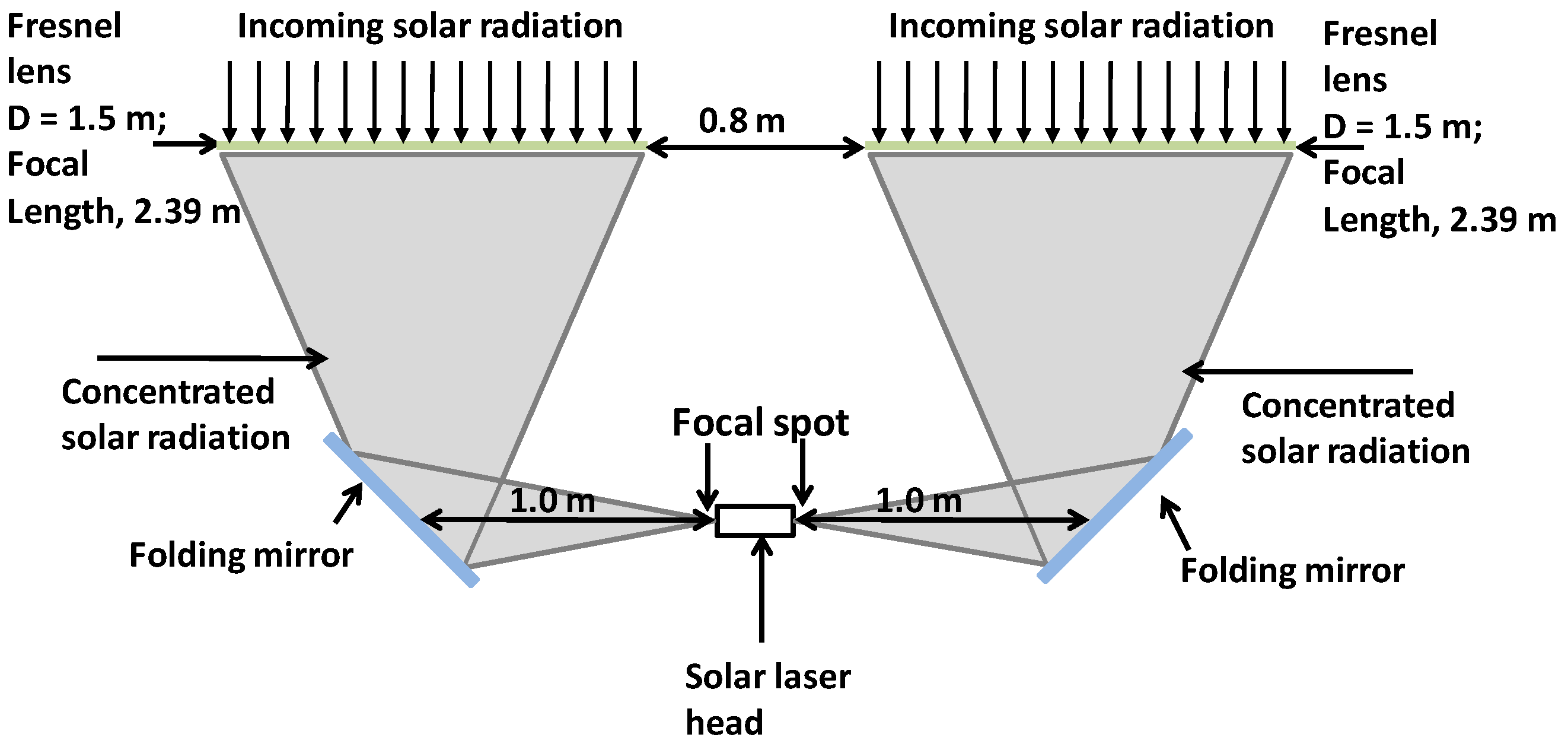
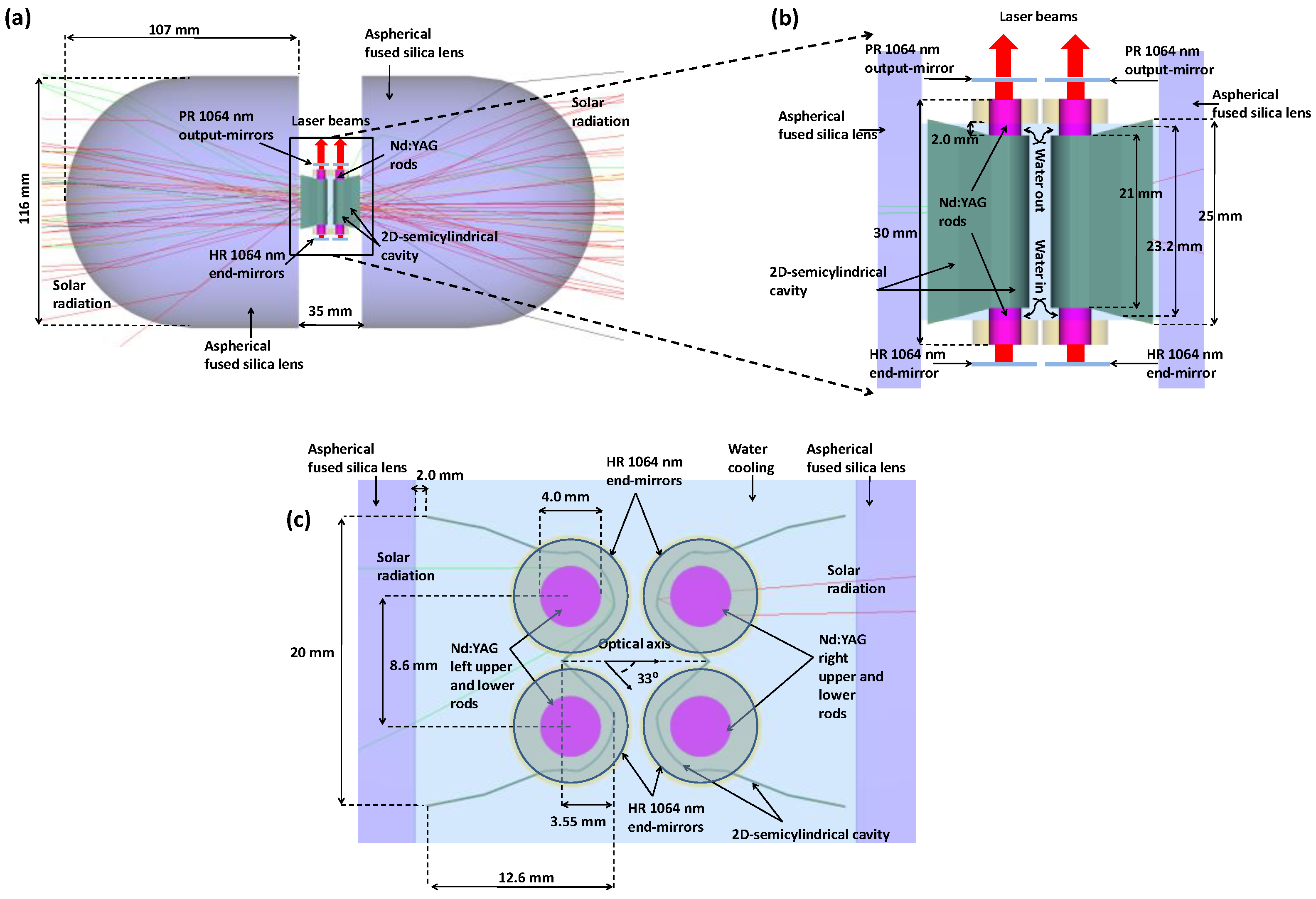
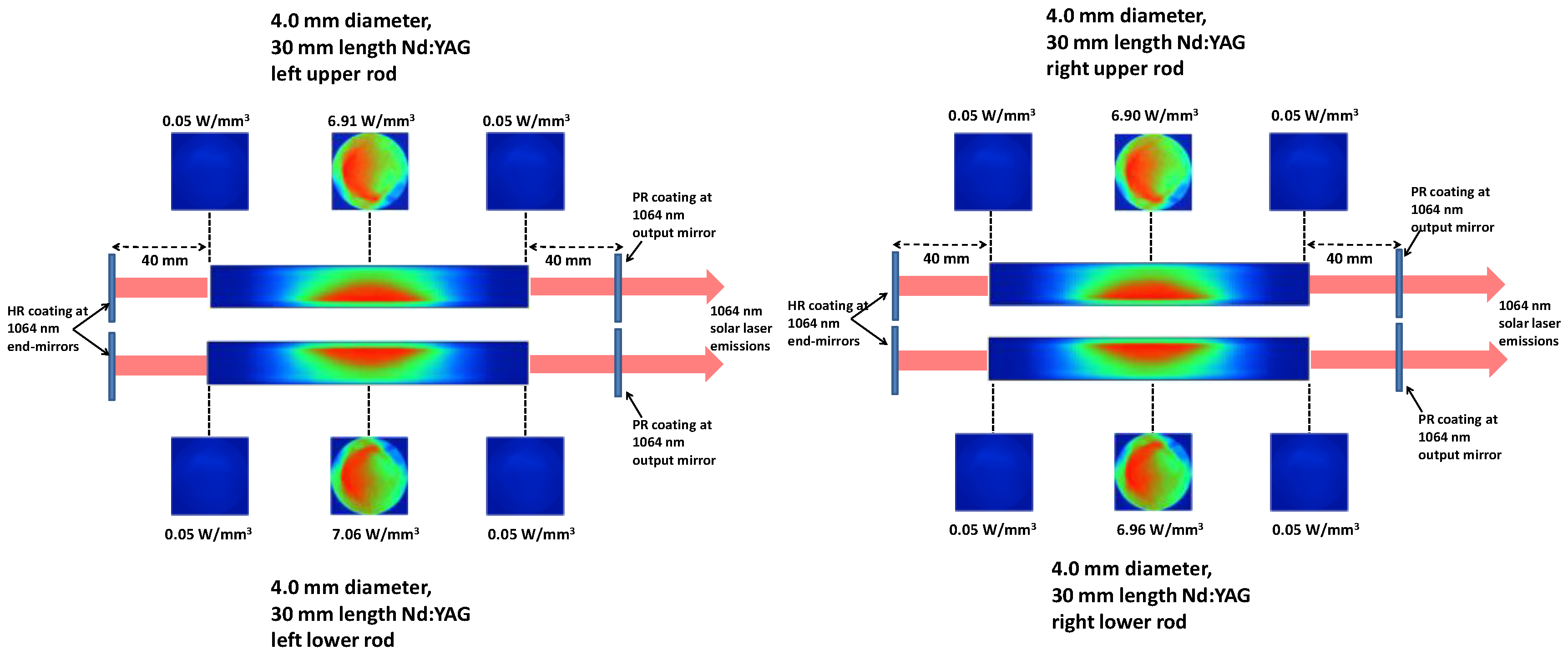
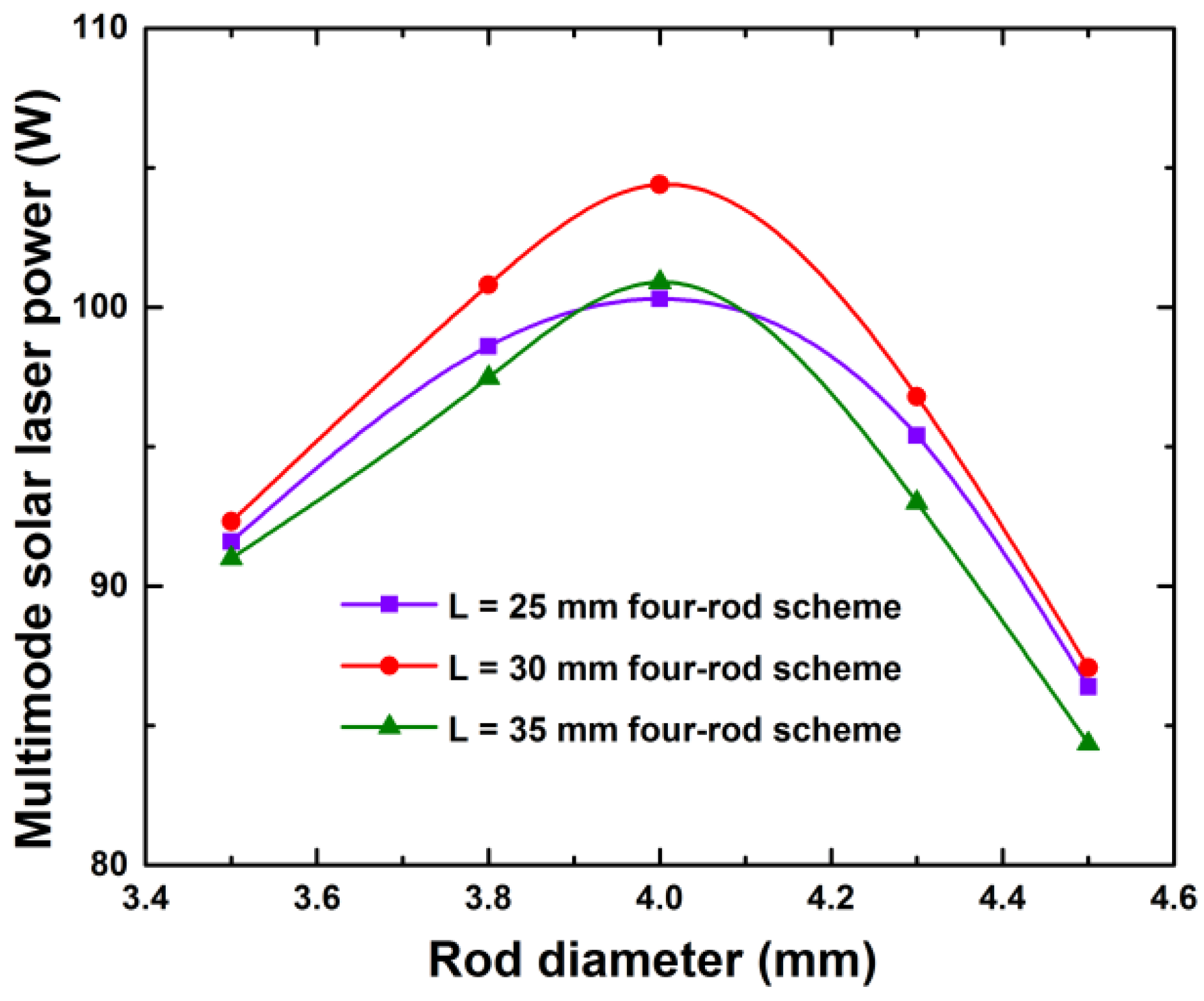
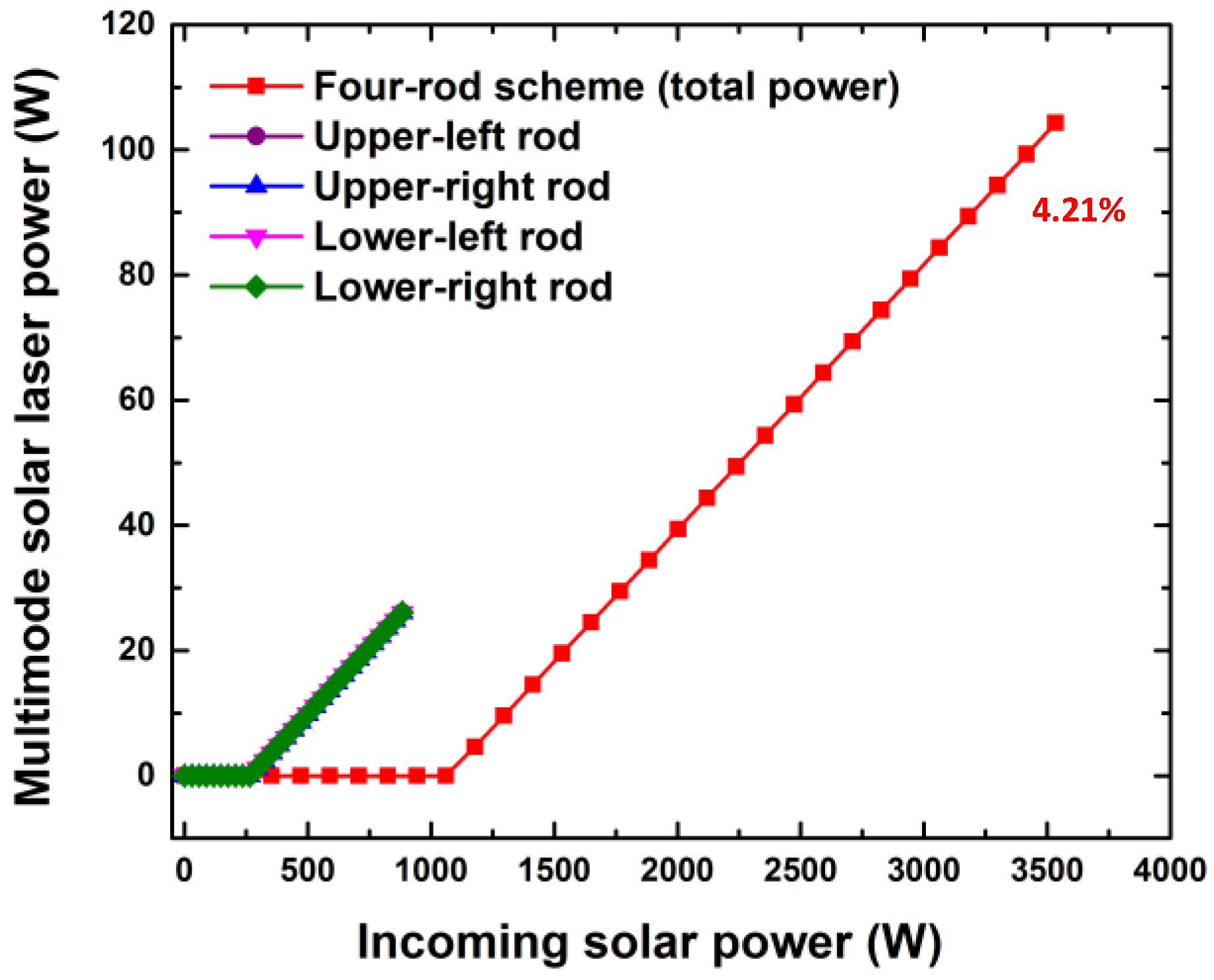
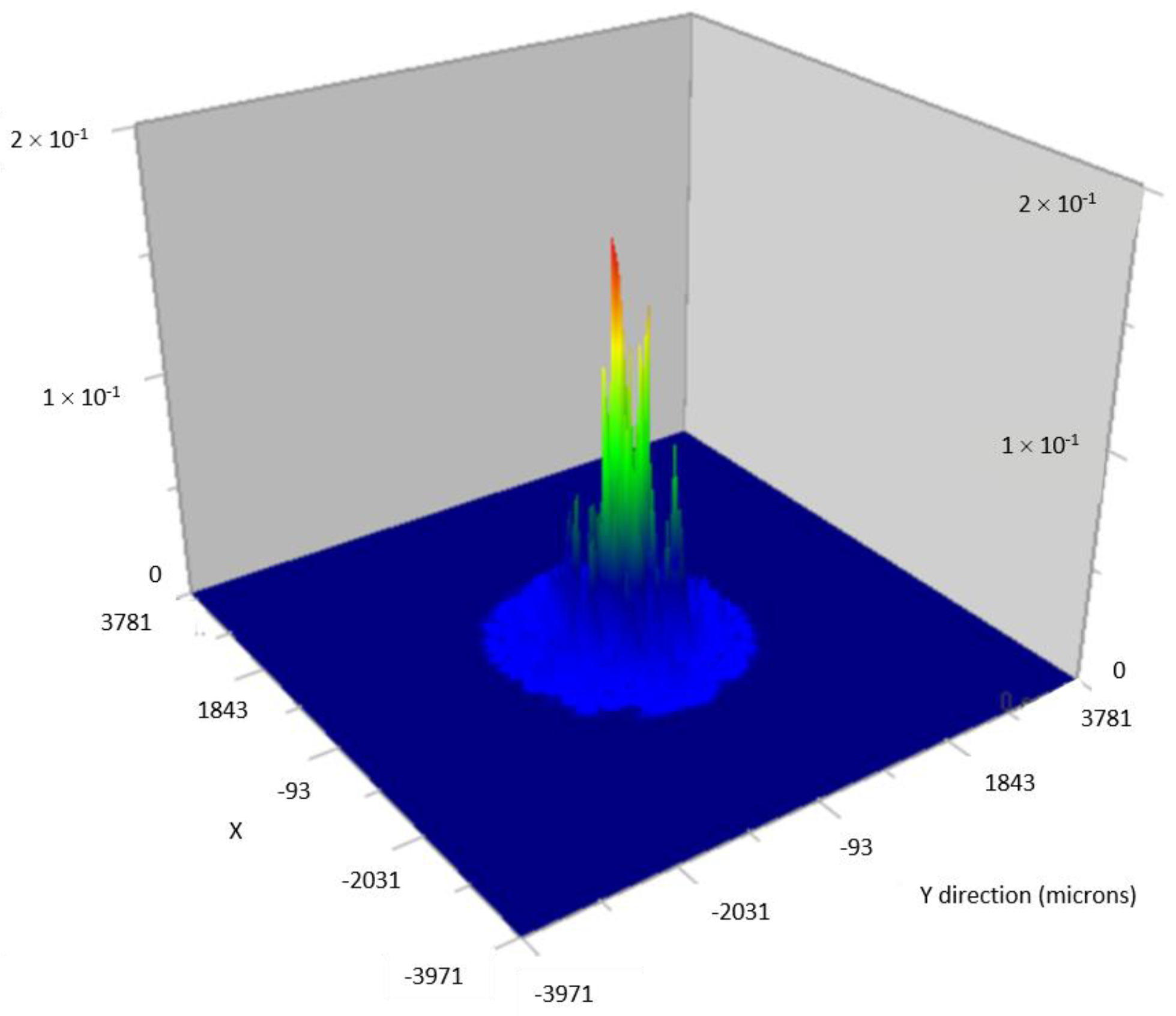
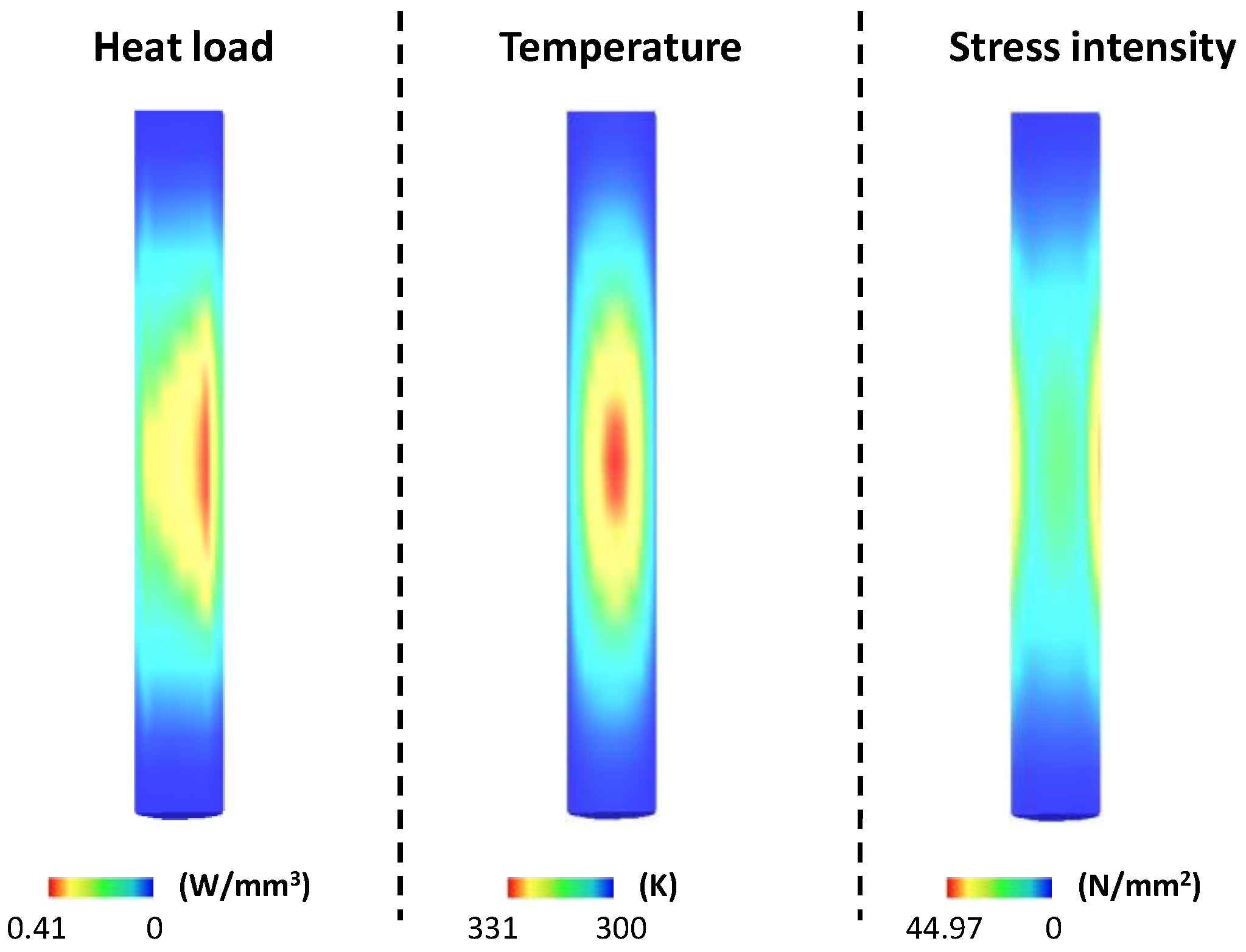
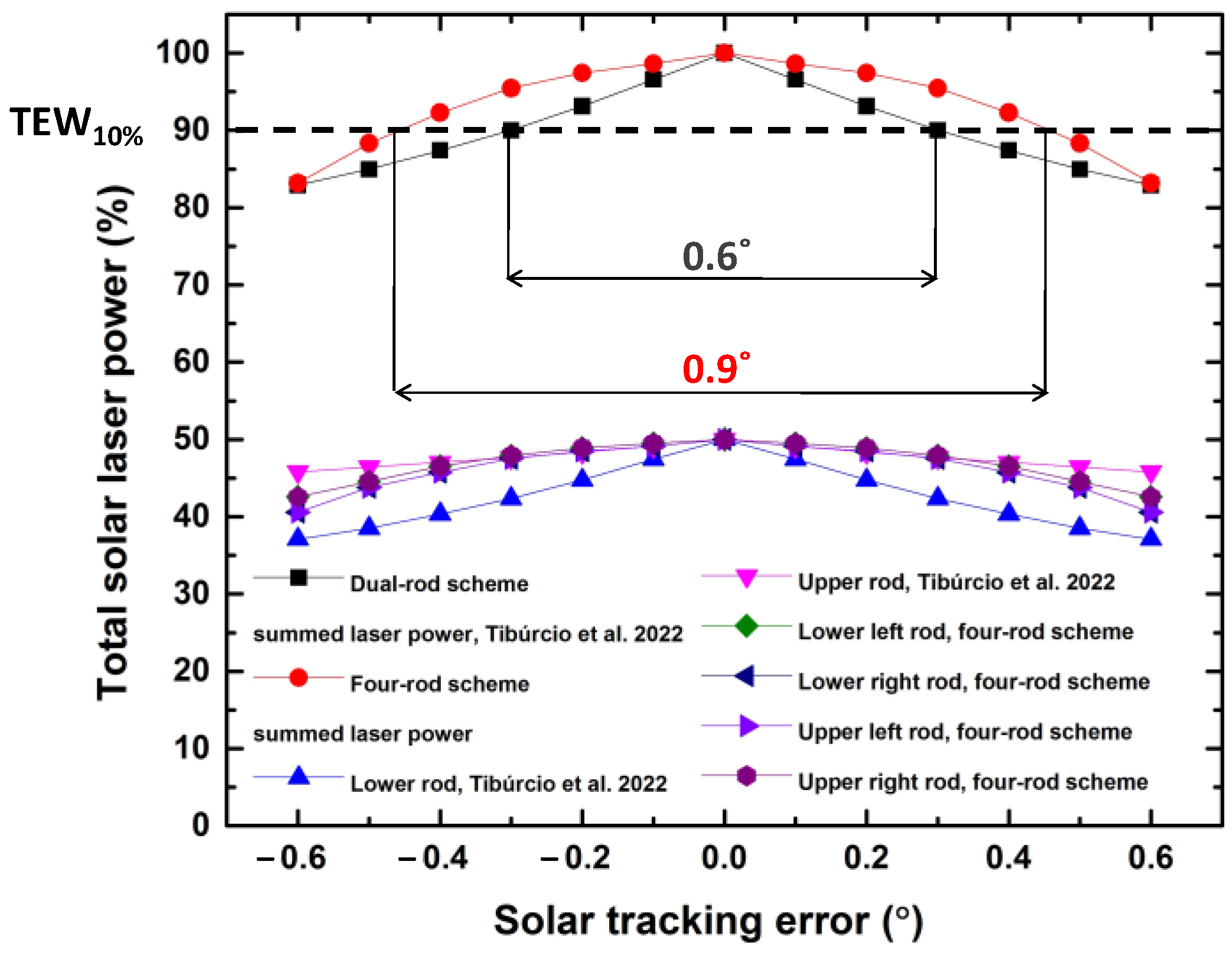

| Parameter | ||||
|---|---|---|---|---|
| Scheme | Laser Output Power (W) | Collection Efficiency (W/m2) | Slope Efficiency (%) | Threshold Pump Power (W) |
| Nd:YAG four-rod side-pumping scheme | 104.4 | 29.7 | 4.21 | 1060 |
| References | Present Numerical Work | ||||
|---|---|---|---|---|---|
| Parameters | Liang et al. [16], End-Side-Pumping Configuration | Dinh et al. [17], End-Side-Pumping Configuration | Guan et al. [21] End-Side-Pumping Configuration | Four-Rod Side-Pumping Scheme with Four Laser Beams | Four-Rod Side-Pumping Scheme with One Laser Beam |
| Laser output power (W) | 9.7 | 120 | 33.1 | 104.4 | 79.8 |
| Collection efficiency (W/m2) | 19.3 | 30 | 32.1 | 29.7 | 22.7 |
| M2 factors (MX2 = MY2) | 10.6 | 137 | 61 | 48 | 24 |
| Brightness figure of merit (W) | 0.086 | 0.0064 | 0.0089 | 0.04 | 0.14 |
Disclaimer/Publisher’s Note: The statements, opinions and data contained in all publications are solely those of the individual author(s) and contributor(s) and not of MDPI and/or the editor(s). MDPI and/or the editor(s) disclaim responsibility for any injury to people or property resulting from any ideas, methods, instructions or products referred to in the content. |
© 2023 by the authors. Licensee MDPI, Basel, Switzerland. This article is an open access article distributed under the terms and conditions of the Creative Commons Attribution (CC BY) license (https://creativecommons.org/licenses/by/4.0/).
Share and Cite
Tibúrcio, B.D.; Liang, D.; Almeida, J.; Garcia, D.; Catela, M.; Costa, H.; Vistas, C.R. Fresnel Lens Solar-Pumped Laser with Four Rods and Beam Merging Technique for Uniform and Stable Emission under Tracking Error Influence. Energies 2023, 16, 4815. https://doi.org/10.3390/en16124815
Tibúrcio BD, Liang D, Almeida J, Garcia D, Catela M, Costa H, Vistas CR. Fresnel Lens Solar-Pumped Laser with Four Rods and Beam Merging Technique for Uniform and Stable Emission under Tracking Error Influence. Energies. 2023; 16(12):4815. https://doi.org/10.3390/en16124815
Chicago/Turabian StyleTibúrcio, Bruno D., Dawei Liang, Joana Almeida, Dário Garcia, Miguel Catela, Hugo Costa, and Cláudia R. Vistas. 2023. "Fresnel Lens Solar-Pumped Laser with Four Rods and Beam Merging Technique for Uniform and Stable Emission under Tracking Error Influence" Energies 16, no. 12: 4815. https://doi.org/10.3390/en16124815
APA StyleTibúrcio, B. D., Liang, D., Almeida, J., Garcia, D., Catela, M., Costa, H., & Vistas, C. R. (2023). Fresnel Lens Solar-Pumped Laser with Four Rods and Beam Merging Technique for Uniform and Stable Emission under Tracking Error Influence. Energies, 16(12), 4815. https://doi.org/10.3390/en16124815








